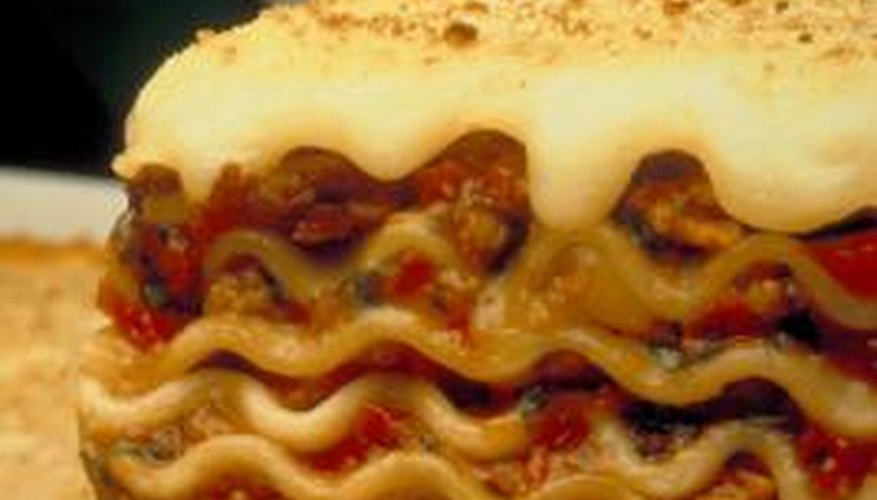Lasagne is meant to be a solid, compact noodle dish that you easily cut into squares. When lasagne contains too much water, it falls apart and the ingredients do not adhere together. The dish can not only be hard to serve but the flavour is also watered down. There are many factors that may contribute to a watery lasagne, all of which are fixable.
Sauce
The main culprit of watery lasagne is the sauce. Watery sauce usually translates into a watery lasagne. If you are using a homemade sauce make sure you simmer it down to a thick sauce before using it. If you are using sauce in a jar you can simmer it in a pan with half a cup of water until all of the water has evaporated and the sauce is thick. You can also add tomato paste to thicken up a homemade or store-bought sauce.
- The main culprit of watery lasagne is the sauce.
- If you are using a homemade sauce make sure you simmer it down to a thick sauce before using it.
Cheese
Lasagne can turn out watery if the cheeses used in the recipe have a high water content. Fresh mozzarella cheese releases a good amount of water when heated. Ricotta contains a lot of water that can accumulate at the bottom of the dish. You can use shredded mozzarella cheese, which does not produce water when melted. Try using a very firm ricotta cheese to eliminate excess water. You can also strain your ricotta before using it. Place the ricotta in a cheese cloth suspended over a bowl until all of the excess water is gone.
- Lasagne can turn out watery if the cheeses used in the recipe have a high water content.
Vegetables and Noodles
Vegetables with water remaining from cooking can also cause a watery lasagne. Make sure to press and strain all of the water out of the vegetables, especially spinach, before layering in the lasagne. The noodles can also be a reason for excess water. Drain the noodles completely before layering. You can also try using the no-cook noodles which soak up water in the dish.
- Vegetables with water remaining from cooking can also cause a watery lasagne.
- You can also try using the no-cook noodles which soak up water in the dish.
Aluminium Foil
Covering the lasagne dish with a heavy aluminium foil will prevent steam and heat from escaping the casserole dish. Steam coming from the water in the other ingredients condenses on the aluminium foil and turns into water which can make lasagne watery. You can try baking the lasagne without any aluminium foil or remove the foil for the last 15 minutes of baking time. Set the oven to heat only from below to prevent the top layer of cheese from cooking too quickly. You can also poke holes with a fork around the aluminium foil. The holes will allow the steam to escape the dish.
- Covering the lasagne dish with a heavy aluminium foil will prevent steam and heat from escaping the casserole dish.
Baking Time
Lasagne can turn out watery if it is not cooked long enough. Many of the ingredients contain water and the water needs time to evaporate. All of the ingredients in lasagne are precooked and the only reason it needs to bake for so long is to melt the cheese, which does not take long, and evaporate the water. If the lasagne is watery after the baking time called for by the recipe, leave it in the oven longer to evaporate the remaining water. You can also try baking at a higher temperature to speed up the process.
- Lasagne can turn out watery if it is not cooked long enough.
- If the lasagne is watery after the baking time called for by the recipe, leave it in the oven longer to evaporate the remaining water.
